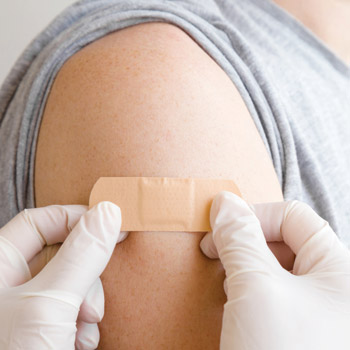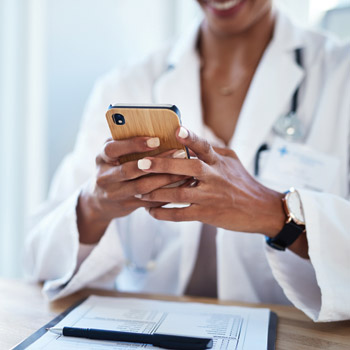Testing offers hope, no panacea for COVID-19 control
A Q&A offers expert advice on the latest information about testing for COVID-19 from Elisa I. Choi, MD, FACP, Governor for ACP's Massachusetts Chapter and a fellow of the Infectious Diseases Society of America.
COVID-19 testing plays a prominent role in guidance on potentially easing physical distancing measures, but the way to best use the current variety of tests remains uncertain. ACP Internist/ACP Hospitalist spoke to internal medicine and infectious disease specialist Elisa I. Choi, MD, FACP, a chief of internal medicine at a multispecialty practice in the greater Boston area, about the types of tests available, how they're being used now, and how they may be used in the future. Dr. Choi is the Governor for ACP's Massachusetts Chapter and a fellow of the Infectious Diseases Society of America.
Q: What are the differences among the types of available COVID-19 tests?
A: For the recently approved saliva-based test, it is premature to consider it as a replacement or substitute for the current standard test of getting a nasopharyngeal or oropharyngeal swab for PCR [polymerase chain reaction] testing. The PCR test is meant for diagnosis of acute infection in real time, determining if someone who presents with symptoms has COVID-19. It is also being used in a test-based strategy to determine suitability to return to work, for individuals who have previously been diagnosed with COVID-19 infection.
The serologic test is inadequate for acute diagnosis of COVID-19. Its role is more suitable for epidemiologic and public health surveillance, by retrospectively determining who was previously infected. Positive COVID-19 antibody tests may be utilized to determine the presenting symptoms of individuals who tested positive, and could be helpful in understanding the varied clinical presentations of COVID-19 disease, particularly if there were initially atypical symptoms. Antibody tests are a good tool to determine the epidemiology of COVID-19 infection, but are not reliable for acute disease diagnosis.
It is also very uncertain exactly how significant of a role the serologic test will have in determining if someone is “safe” to return to work. Given that this is a brand-new infection affecting the human population, we do not currently have adequate understanding of what positive antibody results on COVID-19 serology will mean in terms of whether individuals who test positive are fully immune from future infection.
Q: Tests are now being done in different settings and manners throughout the country. The FDA also recently authorized a self-testing kit. How much variation might there be in the results of these different approaches?
A: Variation in results can arise from a number of different factors. If a person is getting tested when they are less symptomatic or at the end of their illness, they may have a different result than if they were tested earlier in the illness at the height of their symptoms. Another variable to consider with the testing and the test results is sampling. If there is any variation in how the person is sampled, such as depth and duration of sampling, it can lead to differences in results. Currently, nasopharyngeal and oropharyngeal routes are valid ways to sample. Obtaining one's own samples from these routes can prove to be technically challenging, and particularly for the nasopharyngeal route, may be uncomfortable to perform. These factors can therefore affect the adequacy of sampling and also the accuracy of the test results.
Drive-through testing minimizes the duration of face-to-face contact and exposure between an individual who may have COVID-19 infection and the person who is performing testing. It also helps prevent that individual being tested from other exposures that they may face if they were seen in an emergency department, clinic, or a hospital, where there are other ill patients. Drive-through COVID-19 testing helps to facilitate rapid testing in an efficient way, minimizing exposure to both the tester and the patient.
Self-testing is not yet, at this time, ready to replace direct testing, because of the previously mentioned caveats about sampling issues from self-testing. Not every individual will be able to accurately self-test, either, due to technical difficulties with sampling, and that can lead to reduced accuracy of results, as well.
Q: How are hospitals monitoring and testing for infection among clinicians?
A: The role of testing and surveillance of employees is not universally consistent at this time, and there may be different practices depending on the particular hospital's or health care organization's employee health and human resources guidelines. The variation in testing practices is partially dependent on the availability of COVID-19 tests, and the desire to preserve enough testing kits to evaluate patients who may be suspected of having COVID-19. Most testing is generally directed at symptomatic persons, though there may be some specific situations where testing of asymptomatic individual employees would be recommended, if there were high-risk situations or exposures. For purposes of monitoring the employees, many hospitals and health care organizations conduct daily symptoms inventory or daily temperature checks before the employee's shift or before reporting to work, or some combination of temperature logs and symptom inventory.
Q: For clinicians who are infected or are thought to be infected, is testing involved in deciding whether they can come back to work?
A: This is often very organization dependent. Let's say a clinician was exposed to someone, either a patient or another coworker, who was a definite COVID-19-positive case. At this juncture, we are not always testing that exposed individual after their exposure if they are asymptomatic because the role of testing in asymptomatic individuals is generally not pursued. The standard currently is to have the clinician who had the COVID-19 exposure self-quarantine and monitor their symptoms for at least 14 days. In many cases, there is no requirement to do a COVID-19 test before coming back, if that clinician who had exposure to COVID-19 has remained symptom free and feeling well during the entire period of self-quarantine.
Testing may come into play if somebody has been diagnosed with COVID-19 and then they need to return to work. But even that testing, as part of a test-based strategy for return to work, is not utilized universally. Some organizations utilize a time-based or symptom-based strategy in determining when a COVID-19-infected clinician can return to work that requires the COVID-19-positive clinician to monitor themselves at home until they have had at least 72 hours of symptom resolution with no fevers (absent any fever-reducing medications), and also to have that COVID-19 clinician self-isolate for at least 7 to 10 days after onset of infection. Whether a COVID-19-infected clinician needs to get tested before returning to work depends on the type of strategy used to determine when they are able to come back to work, either a test-based strategy or a time/symptoms-based strategy.
Q: How are tests being used to make discharge decisions?
A: A testing-based strategy for this decision-making will involve obtaining a COVID-19 test, and then at least 24 hours later repeating another COVID-19 test, with two negative consecutive tests supporting a decision to discharge. However, not all hospitals, nursing homes, and other health care facilities are utilizing that strategy. The decision to use COVID-19 testing in discharge decisions may be determined by different factors, such as the availability of testing kits, and other epidemiologic factors, such as the risk of secondary transmission. The intensity of surveillance for discharging to a nursing home may be prioritized more frequently than if being discharged back home, since the risk of secondary transmission of COVID-19 from an infected individual is greater in congregate settings. If someone is being discharged to home, they can be advised to continue to monitor their symptoms and practice physical distancing, and if that can be implemented, the risk of secondary transmission is much less substantial and significant.
Q: How can testing help inform decisions about ending physical distancing measures?
A: Both PCR and serologic tests have limitations in their potential use to determine when to end physical distancing measures. Questions that remain, despite our current COVID-19 tests, are: What does a positive serologic test result mean, in terms of immunologic protection from re-infection? What does a positive PCR test result, in a “recovered” individual who no longer has any symptoms, mean for risk of transmission of infection? What does a positive PCR test result mean in an individual who is asymptomatic, with respect to risk of infecting other individuals? What does a positive serology test mean in terms of duration of immunologic protection? We still do not know the answers yet to these questions. However, it is still important to provide a more abundant supply of PCR tests, because there continues to be a need to diagnose and evaluate patients for acute COVID-19 infection as this pandemic is still very active. There is also benefit to the serologic tests to advance our understanding of the dynamics of COVID-19 and its disease course. However, there is no definitive approach yet in incorporating testing to determine when to end physical distancing measures. The COVID-19 tests currently available can help inform the decisions about physical distancing, but they are part of many factors that should be considered. They do not provide a simple “yes” or “no” answer to the decision to end physical distancing.
Q: We've heard that a vaccine is about 12 to 18 months away at the earliest estimate, and testing is going to continue to develop. How do you see this playing out over the next year?
A: A COVID-19 vaccine will not be a quick fix or an easy answer, despite the excitement about upcoming vaccine trials. Initial trials will be preclinical and there still needs to be safety testing and additional clinical trials, and then a determination of exactly how many doses of a vaccine will be effective for protection. More widespread testing is also exciting but it will not make decision-making any simpler. It will provide more tools to evaluate and diagnose COVID-19 infection, but there is still a lot more information we need to learn about this illness.
As more testing options become available, we will continue to gain more understanding about COVID-19 disease. With more widespread testing, we may start to see a lot more variability in the kind of symptoms characterizing COVID-19 disease, including atypical symptoms. We have already learned so much now compared to one to two months ago, and particularly with the intensity of focus on this pandemic, we are learning something new every day. However, it will be a more gradual process of understanding COVID-19 rather than a sudden realization about how to conquer this disease.




